
The member-state representatives, including Swiss president Pascal Couchepin, French prime minister François Fillon and several ministers, applaud CERN’s director-general, Robert Aymar, during the opening presentation. “The LHC is a marvel of modern technology, which would not have been possible without the continuous support of our member states,” he said. “This is an opportunity for me to thank them on behalf of the world’s particle-physics community.”
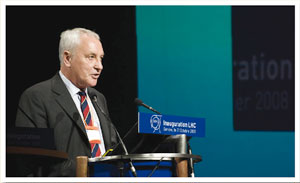
The LHC inauguration ceremony officially marked the end of 24 years of conception, development, construction and assembly of the biggest and most sophisticated scientific tool in the world. After the LHC was proposed in 1984, it was 10 years before Council approved the project. “Its construction has taken more than 14 years and there have been many challenges, which have all been overcome,” said the LHC project leader, Lyn Evans, in his speech at the ceremony. “We are now looking forward to the start of the experimental programme, where new secrets of nature will undoubtedly be revealed.”
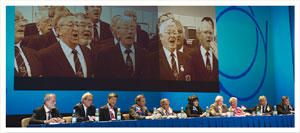
A highlight of the presentation by Lyn Evans was an excerpt from a recording made on 12 October when the Morriston Orpheus Choir from Swansea was joined by Welsh first minister Rhodri Morgan in the CERN Control Centre and blessed the LHC with song.

François Fillon (third from right), prime minister of France, in the LHC tunnel near the CMS experiment, together with Philippe Lebrun (right), head of the Accelerator Technology Department at CERN. In his speech later, Fillon said: “When the decision was taken to construct the LHC, I was minister for higher education and research. I fought for this project, which some regarded as an impossible dream. I believe that this dream can be realized. That was 14 years ago. Today the facility exists and it is spectacular.”
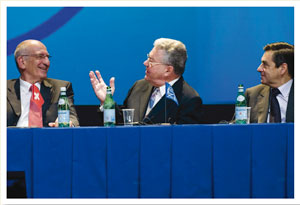
Director-general Robert Aymar (centre) with leaders of CERN’s two host states: Pascal Couchepin (left), president of the Swiss Confederation, and François Fillon, prime minister of the Republic of France.

Ján Mikolaj, deputy prime minister and minister of education of the Slovak Republic, during his presentation at the ceremony. “We know of the importance of fundamental research,” he said. “We also know that CERN is a driving force for development of new technologies.”

Annette Schavan, Germany’s federal minister of education and research, being greeted by Robert Aymar. One of three ministers who gave speeches during the ceremony, she noted that CERN: “Reflects the strength of research in a special way: the strength that lies behind people’s yearning to find out more about the origins of the universe.”

Ministers wait in line to take their turn as José Mariano Gago (left), Portuguese minister for science, technology and higher education, signs the commemorative electronic plate, watched by CERN’s Carlos Lourenço. During his speech, which was very well received, Gago referred to CERN as “a miraculous scientific laboratory that is a decisive attractor of talent from all over the world”.

This Daruma Doll was originally painted with only one eye to mark the start of the LHC project. It was presented to former CERN director-general Christopher Llewellyn Smith 13 years ago. To mark the end of the project, Toshio Yamauchi (left), senior vice-minister of education, culture, sports, science and technology in Japan, added the second eye and presented the completed doll to current director-general, Robert Aymar (right). Llewellyn Smith witnessed the ceremony together with Swiss president Pascal Couchepin. The Daruma Doll Ceremony is a Japanese tradition that symbolizes the completion of a project.

Carolyn Kuan conducts the Orchestre de la Suisse Romande in Origins, an audiovisual concert specially commissioned for the LHC inauguration. It featured the imagery of National Geographic photographer Frans Lanting and the music of Philip Glass, adapted from Life: A Journey Through Time, which was originally produced in California. The visual score charted the history of the universe from the Big Bang to the present day, and it included imagery from CERN’s experiments.

After the ceremony, guests were treated to a buffet of molecular gastronomy. Chef Ettore Bocchia collaborated with the physics and chemistry departments of Parma and Ferrara universities in Italy to create a scientific feast of Italian cuisine, which was optimized for both taste and health.
Image credit: M Struik.

Musical highlights of the LHCfest for CERN personnel, which followed the official inauguration, included a live performance of the “LHC rap” by AlpineKat, who was joined on stage by a very special backing dancer – none other than the LHC project leader Lyn Evans.
Image credit: M Struik.
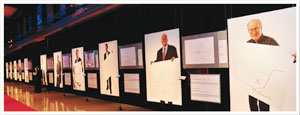
A wall of fame in particle physics greeted VIPs as they entered the ceremony, with photos from the exhibition Accelerating Nobels, beginning (right) with Donald Glaser, inventor of the bubble chamber, who received the Nobel Prize in Physics in 1960. Between 2006 and 2008, photographer Volker Steger, with the help of CERN and the Lindau Meetings Foundation, photographed more than 40 Nobel laureates and invited each of them to draw their most important discoveries.
Image credit: M Struik.

Accelerating Nobels is an exhibition that centres on 19 laureates whose work is closely related to CERN and the LHC. The exhibition has been on view at CERN in the Globe of Science and Innovation, where CERN’s Nobel laureates, including Carlo Rubbia (left) and Simon van der Meer, took pride of place.

Over the past decade, industry has played an important part in developing, building and assembling the LHC, its experiments and the computing infrastructure. To thank industry for its exceptional contributions to the LHC project, CERN organized a special industry day on 20 October. More than 70 companies attended. Here Lucio Rossi, who led the LHC magnet construction, addresses the assembled participants.
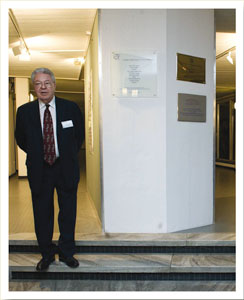
Ten firms were honoured on the industry day for their fundamental contributions to the LHC machine, detectors and computing grid: Ineo GDF Suez, Air Liquide, Alstom, ASG Superconductors, ATI Wah Chang, Babcock Noell, Intel, Linde Kryotechnik, Luvata Group and Oracle. A plaque in the lobby area near CERN’s main auditorium, unveiled by the director-general during the day, commemorates their exceptional contributions.
• For a video of the highlights of the ceremony see http://cdsweb.cern.ch/record/1136012.





